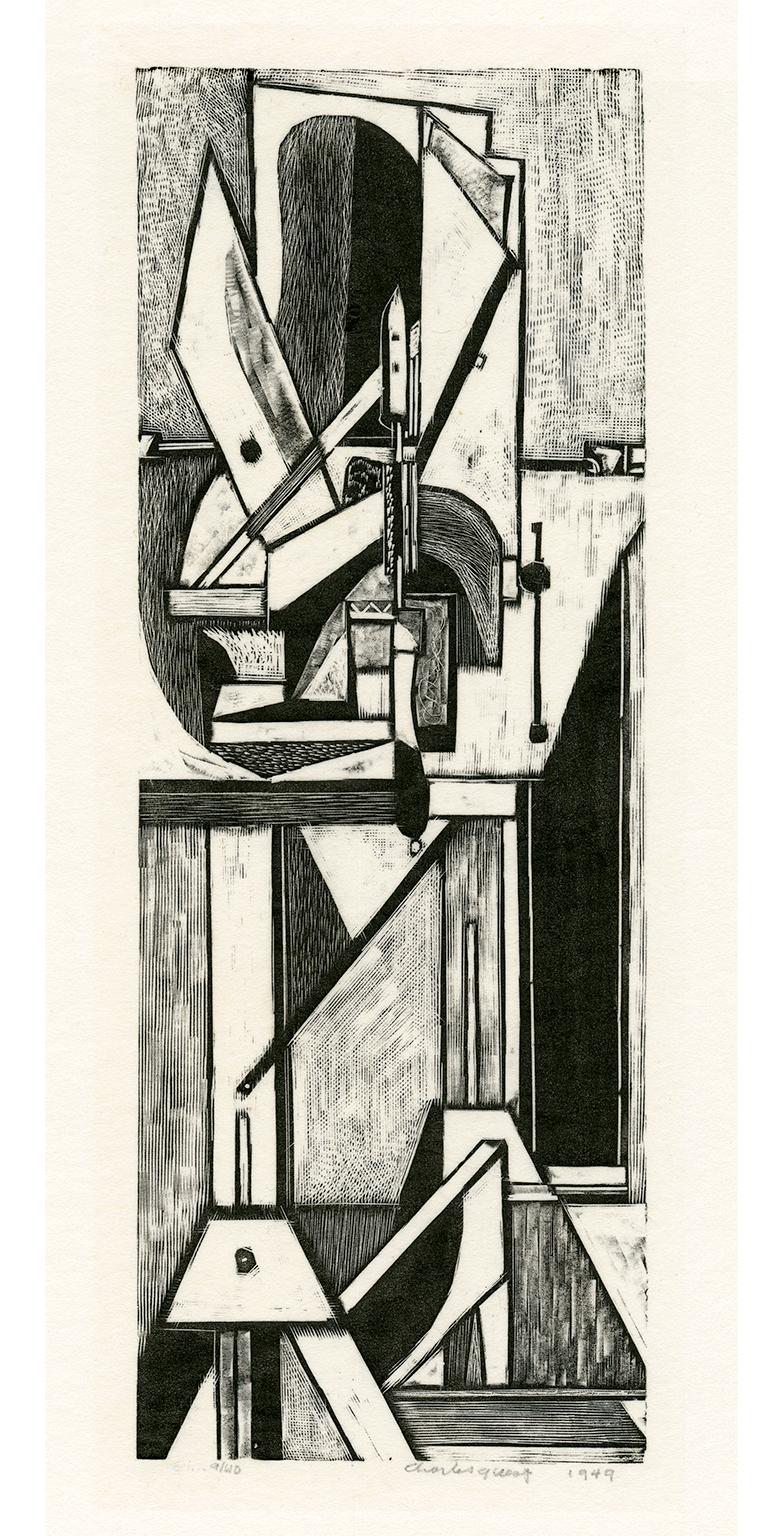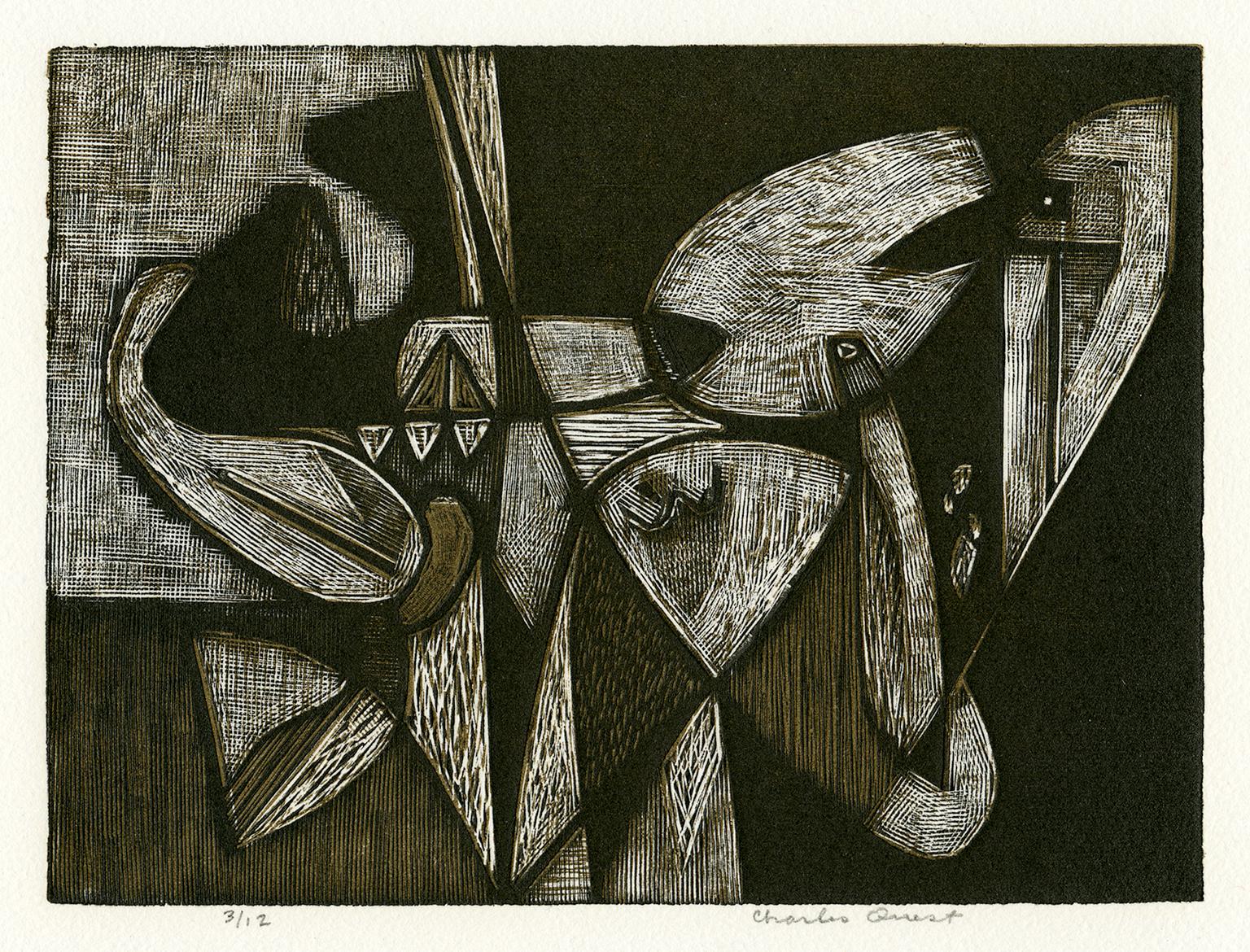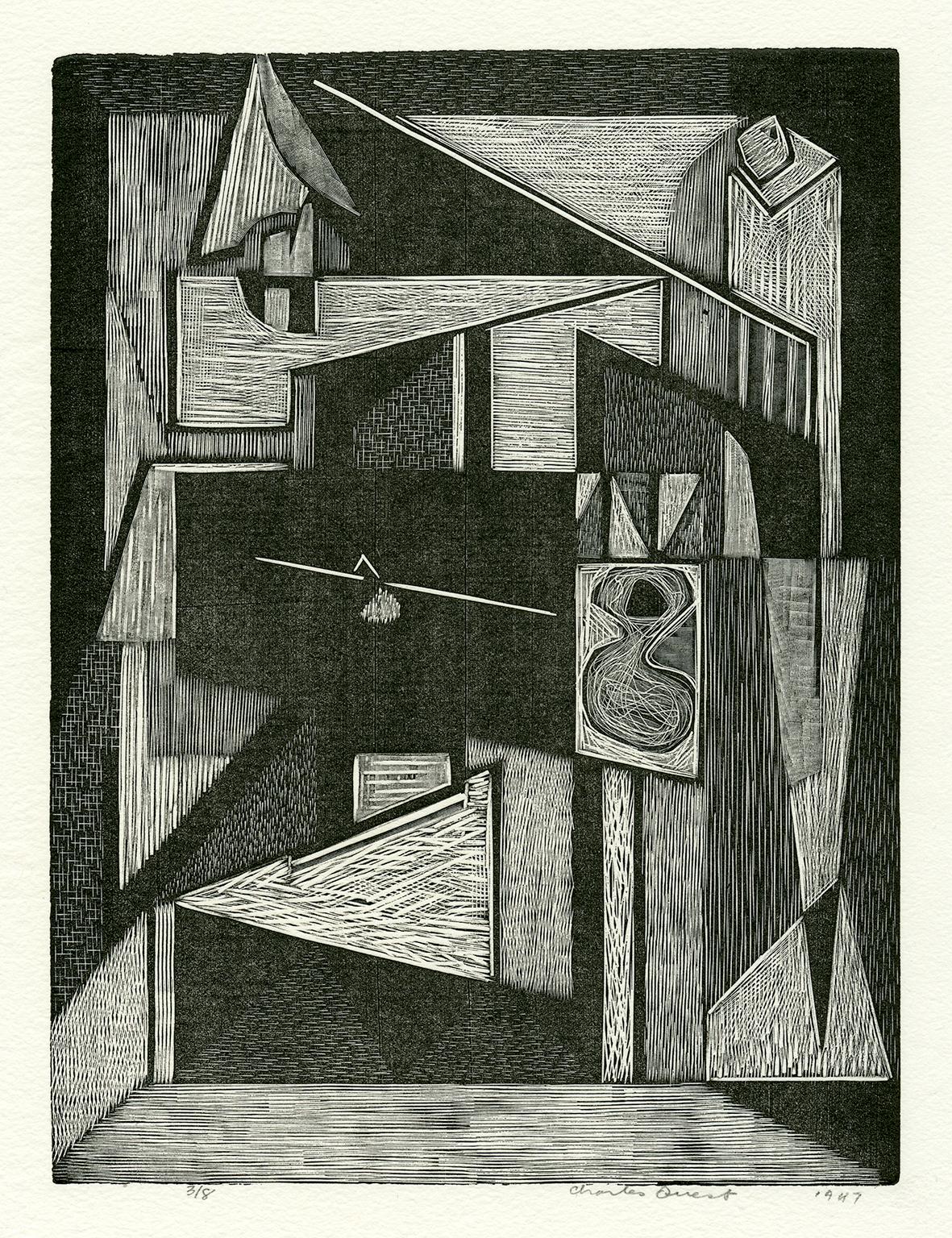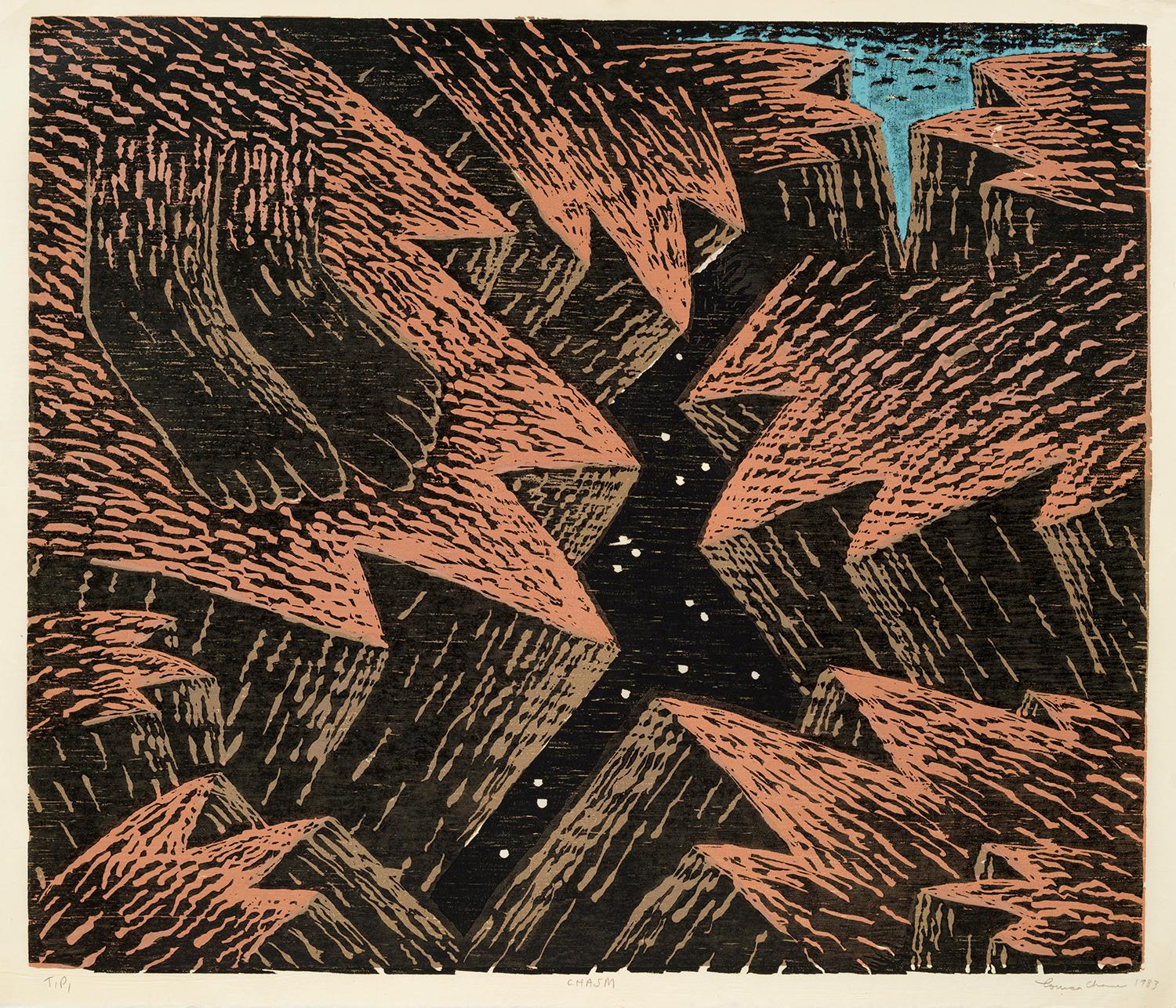Want more images or videos?
Request additional images or videos from the seller
1 of 8
Louisa ChaseUntitled (Black Sea)1983
1983
About the Item
Louisa Lizbeth Chase was born in 1951 to Benjamin and Wilda Stengel Chase in Panama City, Panama, where her father, a West Point graduate, was stationed. The family moved to Pennsylvania in 1958. Chase attended the George School, a private Quaker-sponsored boarding school in Bucks County. Initially intending to study classics at Syracuse University, she discovered printmaking and graduated with a Bachelors in Fine Arts in 1973. A Yale summer program confirmed her direction and she enrolled at the Yale University School of Art, earning her Masters in Fine Arts (MFA) degree in 1975. It was clear, early on, that Louisa Chase was special. In her final year in graduate school, she was selected for a solo show of “floor pieces” at the Artists Space, a non-profit gallery dedicated to showcasing emerging talent, located on Wooster Street in the heart of Soho, Manhattan’s burgeoning artist neighborhood. Degree in hand, Chase moved to downtown Manhattan, and became a part of the vibrant downtown art scene of the late 1970s and 1980s. As a young artist, Chase did what other young artists do. She taught—commuting to the Rhode Island School of Design in Providence from 1975 to 1979, and closer to home at the School of Visual Arts in Manhattan, from 1980 to 1982. In her downtown studio, she painted, made prints, and explored woodblock. As she worked, she garnered a series of solo shows and participated in a host of group exhibitions highlighting contemporary artists, including Barbara Rose’s 1979 manifesto at the Grey Art Gallery, New York University, “American Painting: The Eighties;” the Whitney Museum Biennial in 1982; and the American group contribution to the Venice Biennale in 1984. Chase’s work attracted serious, positive, and respectful notice in the art press, including, among many others, The Village Voice (Kim Levin, “The Secret Life of Louisa Chase,” Jan. 28, 1981), The New York Times (‘Louisa Chase,” February 17, 1989), and Arts Magazine (Richard Kalina “Louisa Chase,” May 1989, p. 90). Throughout her career, Chase remained a questing spirit, freely experimenting with various media. Similarly, her oeuvre reveals a variety of approaches at different times, so that, despite having attracted a number of labels, among them “new image school,” and “neo expressionist,” there is not one distinctive “Chase style.” Her credited influences range from the medieval Italian Sienna painters through Jackson Pollack. What never wavered was the artist’s intention to make visual on canvas her inner emotional state. In 1979, Chase wrote “painting for me is a constant search to hold a feeling tangible” (as quoted by Alexandra Anderson-Spivy in Finding a New Language: Louisa Chase’s Recent Paintings, exhib. cat. Foundation Kajikawa, Kyoto, Japan, 1991, p. 6). For a 1982 group show at the Whitney Museum, Chase wrote that “The forces closest to landscape are the closest to the internal forces that I am trying to understand. . . . The location is inside.” Chase’s work is represented in the permanent collections of a number of noted museums—the Whitney Museum of Art in New York; the Museum of Modern Art, New York (MOMA); the Metropolitan Museum of Art, New York; The National Gallery of Art, Washington, D.C.; the Brooklyn Museum; The Walker Art Center, Minneapolis, Minnesota; the Albright-Knox Art Gallery, Buffalo, New York; the Baltimore Museum of Art; the Butler Institute of American Art, Youngstown, Ohio; and the Nelson-Atkins Museum of Art, Kansas City, Missouri. In 1991, Chase moved to Sag Harbor, on the eastern end of Long Island, and then to nearby East Hampton where she bought a small 1930 farmhouse with a separate studio. As with lower Manhattan, Chase chose a location with an art community that was congenial and collegial. She was living in East Hampton when she died in 2016 after a seven-year-long struggle with cancer.
- Creator:Louisa Chase (1951 - 2016, American)
- Creation Year:1983
- Dimensions:Height: 33.5 in (85.09 cm)Width: 38.88 in (98.76 cm)
- Medium:
- Movement & Style:
- Period:
- Condition:
- Gallery Location:New York, NY
- Reference Number:
About the Seller
5.0
Recognized Seller
These prestigious sellers are industry leaders and represent the highest echelon for item quality and design.
Established in 1952
1stDibs seller since 2010
Typical response time: 6 hours
Associations
Art Dealers Association of America
- ShippingRetrieving quote...Ships From: New York, NY
- Return PolicyThis item cannot be returned.
More From This SellerView All
- ChasmBy Louisa ChaseLocated in New York, NYLouisa Lizbeth Chase was born in 1951 to Benjamin and Wilda Stengel Chase in Panama City, Panama, where her father, a West Point graduate, was stationed. The family moved to Pennsylv...Category
1980s American Modern Abstract Prints
MaterialsWoodcut
- American Landscape: Houses, Gardens and TreesBy Ralph RosenborgLocated in New York, NYSigned (at lower right): Ralph M. Rosenborg 1939; ll: 3/15 WoodcutCategory
Mid-20th Century American Modern Abstract Prints
MaterialsWoodcut
- Opus EightLocated in New York, NYNaum Gabo was a major constructivist sculptor and highly influential member of the European avant-garde art movement. Gabo signaled a rejection of conventional sculptural modes by em...Category
20th Century American Modern Abstract Prints
MaterialsMonoprint
- Prefatio, from the Graphic Tectonics SeriesBy Josef AlbersLocated in New York, NYEdition: 34. This impression is one of only two proofs printed on graph paper. Printed by Reinhard Schumann, Hickory, North Carolina. Reproduced in Formulation: Articulation (portfol...Category
20th Century American Modern Abstract Prints
MaterialsScreen
- Bar HarborLocated in New York, NYEdition: 5 or less. One of possibly 3 variantsCategory
20th Century American Modern Abstract Prints
MaterialsMonotype
- Yours TrulyBy Arthur DoveLocated in New York, NYYours Truly is a work of 1927, a fertile year for Dove, capped by a solo exhibit at Stieglitz’s “The Intimate Gallery,” which included this picture. From 1924 through 1930, Dove produced a notable series of collages, interspersed with drawings, pastels, and oil paintings on a variety of supports. In 1927, the same year that Dove painted Yours Truly, he found inspiration in American popular music, often referring in his titles to works by George Gershwin and Irving Berlin. Yours Truly was the title of a Broadway musical that opened at the Shubert Theater on January 25, 1927. Gene Buck, the producer, had collaborated with Raymond Hubbell, the composer, on the Ziegfield Follies shows of 1923, 1924, and 1925. The production, which contained the title song, “Yours Truly,” ran for 127 performances, closing on May 14, 1927. Given the context of Dove paintings...Category
1920s American Modern Paintings
MaterialsOil, Canvas
You May Also Like
- Work Bench — Mid-century ModernBy Charles QuestLocated in Myrtle Beach, SCCharles Quest, 'Work Bench', 1949, wood engraving, edition 40. Signed, dated and numbered 9/40 in pencil. Titled and annotated 'wood engraving 1949' in pencil, in the artist’s hand, lower right margin. A fine, richly-inked impression, on off-white wove Japan, with full margins (1 3/4 to 2 inches), in excellent condition. Matted to museum standards, unframed. ABOUT THE ARTIST Charles Quest, a successful artist, and fine art instructor, worked in a variety of mediums including mosaic, stained glass, mural painting, and sculpture, but remains best known as a printmaker. Quest grew up in St. Louis, his talent evident as a teenager when he began copying the works of masters such as Michelangelo on his bedroom walls. He studied at the Washington University School of Fine Arts where he later taught from 1944 to 1971. He traveled to Europe after his graduation in 1929, and studied at La Grande Chaumière and Academie Colarossi, Paris, continuing to draw inspiration from the works of the Old Masters. After returning to St. Louis, Quest received several commissions to paint murals in public buildings, schools, and churches, including one from Joseph Cardinal Ritter to paint a replica of Velasquez's Crucifixion over the main altar of the Old Cathedral in St. Louis. Quest soon became interested in the woodcut medium which he apparently learned through his study of J. J. Lankes' A Woodcut Manual (1932) and Paul Landacre's articles in American Artist magazine ‘since no artists in St. Louis were working in wood’ at that time. Quest also revealed that for him, wood cutting and engraving were ‘more enjoyable than any other means of expression.’ In the late 1940s, his graphic works began attracting a lot of critical attention—several of his woodcuts won prizes and were acquired by major American and European museums. His wood engraving entitled ‘Lovers’ was included in the American Federation of Art's traveling print exhibition in 1947. Two years later Quest's two prize-winning prints, ‘Still Life with Grindstone’ and ‘Break Forth into Singing’ were exhibited in major American museums in a traveling show organized by the Philadelphia Print Club. His work was included in the Chicago Art Institute's exhibition, ‘Woodcut Through Six Centuries’ and the print ‘Still Life with Vise’, was purchased by the Museum of Modern Art in New York. In 1951 he was invited by artist-Curator Jacob Kainen to exhibit thirty wood engravings and color woodcuts in the Graphic Arts Division of the Smithsonian's National Museum (now known as the American History Museum). This one-man exhibition was a remarkable achievement for Quest, who had been working in the medium for only about ten years. In the press release for the show, Kainen praised the ‘technical refinement’ of Quest's work: ‘He obtains a great variety of textural effects through the use of the graver, and these dense or transparent grays are set off against whites or blacks to achieve sparkling results. His work has the handsome qualities characteristic of the craftsman and designer.’ At the time of the Smithsonian exhibition, Quest's work was represented by three New York galleries in addition to one in his home town. He had also won 38 prizes, and his prints were in the collections of the Library of Congress, the Chicago Art Institute, the Metropolitan Museum and the Philadelphia Museum of Art. In cooperation with the Art in Embassies program, his color woodcuts were displayed at the American Embassy in Paris in 1951. Recognition at home came in 1955 with his first solo exhibition in St. Louis. Press coverage of the show heralded the ‘growth of graphic arts toward rivaling painting and sculpture as a major independent medium’. Charles Quest retired from teaching in 1971 and made relatively few prints in his later years, as the rigors of the medium were too demanding. He moved to Tryon, North Carolina, with his wife Dorothy, an artist and portrait painter, and remained active as a painter until his death in 1993. An exhibition of his prints at the Bethesda Art Gallery in 1983 attracted the interest of Curator Emeritus Joseph A. Haller, S.J., who began purchasing his work for the University's collection. In 1990 Georgetown University Library's Special Collections Division became the grateful recipient of a large body of Quest's work including prints, drawings, paintings, sculpture, and stained glass, as well as his archive of correspondence and professional memorabilia. These extensive holdings, including some 260 of his fine prints, provide a rich opportunity for further study and appreciation of this versatile and not-to-be-forgotten mid-Western American artist...Category
1940s American Modern Abstract Prints
MaterialsWoodcut
- Underwater — Mid-century ModernBy Charles QuestLocated in Myrtle Beach, SCCharles Quest, 'Underwater', 1948, chiaroscuro wood engraving, edition 12. Signed, titled, dated and numbered '3/12' in pencil. A fine, richly-inked impression, in dark brown and warm black, on off-white wove paper, with full margins (5/8 to 1 1/2 inch), in excellent condition. Scarce. ABOUT THE ARTIST Charles Quest, painter, printmaker, and fine art instructor, worked in various mediums, including mosaic, stained glass, mural painting, and sculpture. Quest grew up in St. Louis, his talent evident as a teenager when he began copying the works of masters such as Michelangelo on his bedroom walls. He studied at the Washington University School of Fine Arts, where he later taught from 1944 to 1971. He traveled to Europe after his graduation in 1929 and studied at La Grande Chaumière and Academie Colarossi, Paris, continuing to draw inspiration from the works of the Old Masters. After returning to St. Louis, Quest received several commissions to paint murals in public buildings, schools, and churches, including one from Joseph Cardinal Ritter, to paint a replica of Velasquez's Crucifixion over the main altar of the Old Cathedral in St. Louis. Quest soon became interested in the woodcut medium, which he learned through his study of J. J. Lankes' A Woodcut Manual (1932) and Paul Landacre's articles in American Artist magazine ‘since no artists in St. Louis were working in wood’ at that time. Quest also revealed that for him, wood cutting and engraving were ‘more enjoyable than any other means of expression.’ In the late 1940s, his graphic works began attracting critical attention—several of his woodcuts won prizes and were acquired by major American and European museums. His wood engraving entitled ‘Lovers’ was included in the American Federation of Art's traveling print exhibition in 1947. Two years later, Quest's two prize-winning prints, ‘Still Life with Grindstone’ and ‘Break Forth into Singing’, were exhibited in major American museums in a traveling show organized by the Philadelphia Print Club. His work was included in the Chicago Art Institute's exhibition, ‘Woodcut Through Six Centuries’, and the print ‘Still Life with Vise’ was purchased by the Museum of Modern Art in New York. In 1951 he was invited by artist-Curator Jacob Kainen to exhibit thirty wood engravings and color woodcuts in a one-person show at the Smithsonian's National Museum (now known as the American History Museum). Kainen's press release praised the ‘technical refinement’ of Quest's work: ‘He obtains a great variety of textural effects through the use of the graver, and these dense or transparent grays are set off against whites or blacks to achieve sparkling results. His work has the handsome qualities characteristic of the craftsman and designer.’ At the time of the Smithsonian exhibition, Quest's work was represented by three New York galleries in addition to one in his home town. He had won 38 prizes, and his prints were in the collections of the Library of Congress, the Chicago Art Institute, the Metropolitan Museum, and the Philadelphia Museum of Art. In cooperation with the Art in Embassies program, his color woodcuts were displayed at the American Embassy in Paris in 1951. Recognition at home came in 1955 with his first solo exhibition in St. Louis. Press coverage of the show heralded the ‘growth of graphic arts toward rivaling painting and sculpture as a major independent medium’. An exhibition of his prints at the Bethesda Art Gallery in 1983 attracted Curator Emeritus Joseph A. Haller, S.J., who began purchasing his work for Georgetown University's collection. In 1990 Georgetown University Library's Special Collections Division was the recipient of a large body of Quest's work, including prints, drawings, paintings, sculpture, stained glass, and his archive of correspondence and professional memorabilia. These extensive holdings, including some 260 of his fine prints, provide a rich opportunity for further study and appreciation of this versatile and not-to-be-forgotten mid-Western American artist...Category
1940s American Modern Abstract Prints
MaterialsWoodcut
- Still Life — Mid-century ModernBy Charles QuestLocated in Myrtle Beach, SCCharles Quest, 'Still Life', 1947, wood engraving, edition 8. Signed, dated, and numbered '3/8' in pencil. Titled and annotated 'wood engraving' in the bottom left margin. A fine impression, on off-white wove paper, with full margins (1 to 2 inches), in excellent condition. Scarce. Matted to museum standards, unframed. ABOUT THE ARTIST Charles Quest, painter, printmaker, and fine art instructor, worked in various mediums, including mosaic, stained glass, mural painting, and sculpture. Quest grew up in St. Louis, his talent evident as a teenager when he began copying the works of masters such as Michelangelo on his bedroom walls. He studied at the Washington University School of Fine Arts, where he later taught from 1944 to 1971. He traveled to Europe after his graduation in 1929 and studied at La Grande Chaumière and Academie Colarossi, Paris, continuing to draw inspiration from the works of the Old Masters. After returning to St. Louis, Quest received several commissions to paint murals in public buildings, schools, and churches, including one from Joseph Cardinal Ritter, to paint a replica of Velasquez's Crucifixion over the main altar of the Old Cathedral in St. Louis. Quest soon became interested in the woodcut medium, which he learned through his study of J. J. Lankes' A Woodcut Manual (1932) and Paul Landacre's articles in American Artist magazine ‘since no artists in St. Louis were working in wood’ at that time. Quest also revealed that for him, wood cutting and engraving were ‘more enjoyable than any other means of expression.’ In the late 1940s, his graphic works began attracting critical attention—several of his woodcuts won prizes and were acquired by major American and European museums. His wood engraving entitled ‘Lovers’ was included in the American Federation of Art's traveling print exhibition in 1947. Two years later, Quest's two prize-winning prints, ‘Still Life with Grindstone’ and ‘Break Forth into Singing’, were exhibited in major American museums in a traveling show organized by the Philadelphia Print Club. His work was included in the Chicago Art Institute's exhibition, ‘Woodcut Through Six Centuries’, and the print ‘Still Life with Vise’ was purchased by the Museum of Modern Art in New York. In 1951 he was invited by artist-Curator Jacob Kainen to exhibit thirty wood engravings and color woodcuts in a one-person show at the Smithsonian's National Museum (now known as the American History Museum). Kainen's press release praised the ‘technical refinement’ of Quest's work: ‘He obtains a great variety of textural effects through the use of the graver, and these dense or transparent grays are set off against whites or blacks to achieve sparkling results. His work has the handsome qualities characteristic of the craftsman and designer.’ At the time of the Smithsonian exhibition, Quest's work was represented by three New York galleries in addition to one in his home town. He had won 38 prizes, and his prints were in the collections of the Library of Congress, the Chicago Art Institute, the Metropolitan Museum, and the Philadelphia Museum of Art. In cooperation with the Art in Embassies program, his color woodcuts were displayed at the American Embassy in Paris in 1951. Recognition at home came in 1955 with his first solo exhibition in St. Louis. Press coverage of the show heralded the ‘growth of graphic arts toward rivaling painting and sculpture as a major independent medium’. An exhibition of his prints at the Bethesda Art Gallery in 1983 attracted Curator Emeritus Joseph A. Haller, S.J., who began purchasing his work for Georgetown University's collection. In 1990 Georgetown University Library's Special Collections Division was the recipient of a large body of Quest's work, including prints, drawings, paintings, sculpture, stained glass, and his archive of correspondence and professional memorabilia. These extensive holdings, including some 260 of his fine prints, provide a rich opportunity for further study and appreciation of this versatile and not-to-be-forgotten mid-Western American artist...Category
1940s American Modern Abstract Prints
MaterialsWoodcut
- (Abstraction) by DDLocated in New York, NYThis image is an extravaganza of modernist motifs. The monogram 'D.D.' is at the lower right.Category
Mid-20th Century American Modern Abstract Prints
MaterialsWoodcut
- Mid Century Modern Woodblock Print, Red Black Group of Figures, American ModernBy Margo HoffLocated in Denver, COWoodblock on colored paper by Margo Hoff (1910-2008) titled 'Observers' of a black and red abstract scene with seventeen figures whose arms are in various positions, looking out at t...Category
20th Century American Modern Abstract Prints
MaterialsPaper, Woodcut
- Portrait of Modern Man - Multilayer Woodblock in Ink on PaperLocated in Soquel, CAPortrait of Anger - Multilayer Woodblock in Ink on Paper Bold and saturated woodblock print of a screaming man by Michael Dow (American, 20th Century). The man is centered in this m...Category
1990s American Modern Figurative Prints
MaterialsPaper, Ink, Woodcut
Recently Viewed
View AllMore Ways To Browse
Modern Chase
Medieval Italian
Italian Black Showcase
Sea Floor
Sea Life Prints Vintage
Vintage George Washington Print
American Woodblock Prints
Vintage Baltimore Prints
Japanese Prints Cats
Japanese Print Cat
Japanese Woodblock Abstract
Vintage Japanese Cat
Sea Cat
Cat Island
Kim Rose
Modern Farmhouse Painting
Alexandra Group
Harbor D Italian




